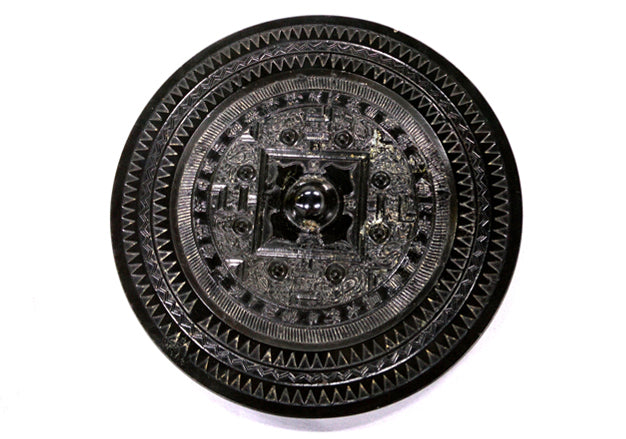
Shangfang bird-and-bird mirror

Shangfang bird and bird Boju pattern mirror, bronze, Eastern Han Dynasty, diameter 13.8 cm. Now in the collection of Henan Museum.
Shangfang bird and bird Boju pattern mirror, round, diameter 13.8 cm, bronze. The name of the mirror comes from the mirror inscription and decoration on the back.
The mirror can be divided into four parts from the center to the outside.
The first part is the square area composed of a round button and four persimmon calyx patterns around the middle of the mirror.
The second part is the area within the inscription belt, which is divided into four areas by four V-shaped patterns. The center of each area is divided into two small areas by a group of TL-shaped patterns, and each small area has a bird.
This type of mirror was first defined as a "TLV" mirror by Western scholars. Later, Japanese scholar Umehara Sueharu named this type of decoration as "rule pattern", and the bronze mirror with this type of decoration was also named "rule mirror". This name was used until the 1980s. Domestic scholar Xiong Chuanxin proposed changing the name of "Guizhi Mirror" to "Boju Pattern Mirror". In 1986, Mr. Fu Juyou directly used the name of "Boju Pattern Mirror" in his article and explained his reasons. [1] Due to the lack of more direct evidence and decades of convention, few people responded. Not long after, when Mr. Zhou Zheng sorted out the old rubbings in the collection of the Chinese History Museum, he found an inscription on a rubbing of the "Four Gods Guizhi Mirror" from the Xinmang period that read "刻具博局去不羊". The two words "博局" provided the most direct evidence for changing the name of "Guizhi Mirror" to "Boju Mirror". Mr. Zhou Zheng stated his point of view in the article "'Guizhi Mirror' Should Be Changed to 'Boju Mirror'" published in the 12th issue of "Archaeology" in 1987 [2]. Since then, "Guizhi Mirror" has been gradually replaced by "Boju Mirror".
The third part is an area composed of a circle with an inscription and short oblique lines. The inscription reads: "Shangfang mirrors are really great. There are immortals who don't know old age. They drink jade springs when thirsty and eat dates when hungry. They travel around the world and live as long as gold and stone."
The "Shangfang" in the text is an official position in the Qin and Han dynasties. Its function in the Eastern Han Dynasty was to "work on imperial swords and other fine objects", which means to make imperial swords and exquisite objects for the emperor. When naming ancient bronze mirrors with inscriptions, the first two characters of the inscription are often taken. The "Shangfang" in the name of this mirror comes from this. Of course, it cannot be concluded that the mirror came from the royal family. Because "Shangfang" mirrors are a large category in the Eastern Han Dynasty, the quality is good and bad, and the "Shangfang mirrors" in the inscription should be a false statement.

Figure 1
There are some variant characters in the mirror inscription, such as the character "Mirror" in the sentence "Shangfang made a mirror really great" does not have the gold radical, the character "Ao" in the sentence "Floating around the world and wandering around the world" does not have the walking radical, and the character "Si" is still four horizontal lines stacked together.
Outside the inscription band is a circle of short oblique lines.
The fourth part is the edge of the mirror, which is wider and has two circles of sawtooth triangles, with double-line wavy lines in between.
The surface of the mirror is shiny black, with no signs of rust, which is what epigraphers call "black lacquer ancient".


![8.3"China Shang Dynasty,Bronze wine cup [Fuhao Jue cup][妇好爵杯]](http://bronzc.com/cdn/shop/files/4ee0482982cfa89bb4d1cff3333a55e6_e3ca0b86-22fc-497d-9afd-578c551225a3-2.jpg?v=1733986652&width=533)

![12.8" China Ming Dynasty, Phoenix-patterned bronze vase[Ming Wanli Phoenix-patterned vase][明万历凤纹瓶]](http://bronzc.com/cdn/shop/files/4ee0482982cfa89bb4d1cff3333a55e6_a516991b-2bb9-4b2f-a2b6-4354129d006c.jpg?v=1733986953&width=533)

![14.6" China Eastern Han Dynasty Bronze vessel in the shape of a flying horse,Also known as bronze galloping horse[Horse Stepping on Flying Swallow][马踏飞燕]](http://bronzc.com/cdn/shop/files/4ee0482982cfa89bb4d1cff3333a55e6_aa3fbeb8-e08b-4a44-929a-13411ca8fb17-2.jpg?v=1733987211&width=533)

![5.9"China Tang Dynasty, Bronze of a walking dragon[Tang Walking Dragon][唐走龙]](http://bronzc.com/cdn/shop/files/2_8cb416b9-ebbd-4fe2-a905-b9277f820c16.png?v=1731488701&width=533)
